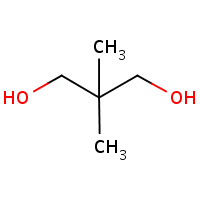Neopentyl glycol
Agent Name
Neopentyl glycol
Alternative Name
2,2-Dimethylpropane-1,3-diol
CAS Number
126-30-7
Formula
C5-H12-O2
Major Category
Other Classes

Synonyms
1,3-Propanediol, 2,2-dimethyl-; 2,2-Dimethyl-1,3-propanediol; 2,2-Dimethyltrimethylene glycol; Dimethylolpropane; Dimethyltrimethylene glycol; Hydroxypivalyl alcohol; Neol; Neopentanediol; Neopentylene glycol; NPG; 2,2-Dimethylpropane-1,3-diol; Propanediol, 2,2-dimethyl-, 1,3-; [ChemIDplus] Dimethylol propane; [CAMEO] 1,3-Dihydroxy-2,2-dimethylpropane; [ICSC] 2,2-Dimethyl-1,3-dihydroxypropane; 2,2-Dimethylolpropan; 2,2-Dimetil-1,3-propandiolo; Dimetilolpropano; Neopentilene glicole; Neopentilglicole; Neopentylglycol; Neopentylglykol; Pentaglycol; [IUCLID]
Category
Alcohols and Polyols, Other
Description
Colorless to white hygroscopic solid; [ICSC] White hygroscopic crystals with a mild odor; [Alfa Aesar MSDS]
Sources/Uses
Used to make plasticizers and polyesters and as modifier of alkyd resins; [Merck Index] Used in chemical synthesis and in the polymers industry; [IUCLID] Used to make large scale and fine chemicals, rubber products, plastic products, textiles, leather, fur, wood and wood products, pulp-paper and paper products, non-metallic mineral products (i.e. plasters and cement), in printing and reproduction of recorded media, building and construction work, scientific research and development, and consumer construction chemicals; [ECHA REACH Registrations]
Comments
An eye and respiratory tract irritant; [ICSC] Effects to male liver and kidney but no reproductive or developmental toxicity observed in oral study of rats; [JECDB] An irritant; May cause smarting and reddening of skin if spilled and allowed to remain on clothes; High vapor concentrations may cause mild smarting of eyes and respiratory system; [CHRIS] A severe eye irritant that may cause injury; [Alfa Aesar MSDS]
Biomedical References
Exposure Assessment
Vapor Pressure
0.225 mm Hg
Lethal Concentration
LCLo (rat) = 39,000 ppm/6hr
NFPA
must be preheated
Diseases, Processes, and Activities Linked to This Agent
Processes
Industrial Processes with risk of exposure: